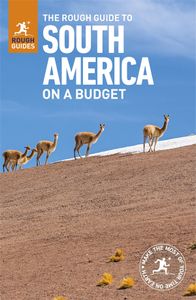Flying over the Nasca Lines
A pricey but spectacular way of seeing the Lines – and arguably the only way to fully appreciate them – is to fly over them. Flights can be arranged with tour companies in Nasca or directly at the Nasca airstrip (where they depart), about 3km south of Nasca (at Km 447 on the Panamericana highway), and cost from $45–250 a person depending on the season, the size of the group, how long you want to spend buzzing around (eg if you want to include Palpa lines as well) and how much demand there is on the day. Flights can last from ten minutes to a couple of hours, with the duration of the average package being 30–45 minutes. Bear in mind that the planes are small and bounce around in the changeable air currents, which can cause airsickness, and that you’ll get a better view on an early morning trip, since the air gets hazier as the day progresses. There have been fatal accidents in recent years, so prices and regulations continue to increase. Many hotels and tour agencies will book a flight for you and arrange transport to the airport from your hotel.
Aeroica
Best booked from the Hotel La Maison Suisse, opposite the airport outside Nasca (01 445 0859 or 034 522434, aeroica.net).
Alas Peruana
Based at the airport (056 522444 or in US +1 800 548 5486, alasperuanas.com). They can also fly in from Ica or Lima.
Nasca ceramics
In 1901, when Max Uhle “discovered” the Nasca culture, it suddenly became possible to associate a certain batch of beautiful ceramics that had previously been unclassifiable in terms of their cultural background: the importance of Nasca pottery in the overall picture of Peru’s pre-history asserted itself overnight. Many of the best pieces were found in Cahuachi.
Unlike contemporaneous Mochica ware, Nasca ceramics rarely attempt any realistic imagery. The majority – painted in three or four earthy colours and given a resinous surface glaze – are relatively stylized or even completely abstract. Nevertheless, two main categories of subject matter recur: naturalistic designs of bird, animal and plant life, and motifs of mythological monsters and bizarre deities. In later works it was common to mould effigies to the pots. During Nasca’s decline under the Huari-Tiahuanaco cultural influence (see The Chimu era), the workmanship and designs were less inspired. The style and content of the early pottery, however, show remarkable similarities to the symbols depicted in the Nasca Lines, and although not enough is known about the Nasca culture to be certain, it seems reasonable to assume that the early Nasca people were also responsible for the drawings on the Pampa de San José. With most of the evidence coming from their graveyards, though, and that so dependent upon conjecture, there is actually little to characterize the Nasca and not much known of them beyond the fact that they collected heads as trophies, that they built a ceremonial complex in the desert at Cahuachi, and that they scraped a living from the Nasca, Ica and Pisco valleys from around 200–600 AD.
Pampa Galeras Vicuña Reserve
Some 90km inland from Nasca, and well signposted at Km 89 of the Nasca–Cusco road, the Pampa Galeras Vicuña Reserve is one of the best places in Peru to see the vicuña, a llama-like animal with very fine wool. The vicuña have lived for centuries in the area of reserve, which is now maintained as their natural habitat and contains more than five thousand of the creatures.
The vicuña themselves are not easy to spot. When you do notice a herd, you’ll see it move as if it were a single organism. They flock together and move swiftly in a tight wave, bounding gracefully across the hills. The males are strictly territorial, protecting their patches of scrubby grass by day, then returning to the rockier heights as darkness falls.
Theories about the Nasca Lines
The Lines are undoubtedly one of the world’s biggest archeological mysteries and bring many thousands of visitors every year to Peru’s south coast. Theories abound as to their purpose and creation.
Maria Reiche
The greatest expert on these mammoth desert designs was Maria Reiche, who escaped from Nazi Germany to Peru in the 1930s and worked at Nasca almost continuously from 1946 until her death in 1998. Standing on the shoulders of US scientist Paul Kosok, a colleague of hers, she believed that the Lines were an astronomical calendar linked to the rising and setting points of celestial bodies on the east and west horizons. The whole complex, according to her theory, was designed to help organize planting and harvesting around seasonal changes rather than the fickle shifts of weather. When certain stars lined up with specific lines, shapes or animals, it would signal a time for planting, the coming of the rains, the beginning or end of summer, the growing season or the time for harvesting. It also gave the elite high priests, who possessed this knowledge, a large element of control over the actions of the populace. In a desert area like Nasca, where the coastal fog never reaches up to obscure the night sky over the pampa, there was a strong emphasis on relating earthly matters to the movements of the heavens and on knowledge of the night skies and how they relate to nature’s cycles. Reiche’s theories, after sixty years of research, are thought to have established some alignments, many of which were confirmed by the computer analysis (particularly those for the solar solstices) of astronomer Gerald Hawkins (world famous for “decoding” Stonehenge in England), who himself spent much of the 1960s working on the Nasca Lines. Much, however, was left unexplained, and this has allowed more recent theorists to fill out the picture.
Theories of rituals
Regarding social aspects of the Lines, Toribio Mejía Xesspe, a Peruvian archeologist, actually “discovered” the site in 1927 and believed that they were made for walking or dancing along, probably for ritual purposes. The archeologist Johan Reinhard, meanwhile, has drawn on present-day anthropological studies from the Peruvian Andes to understand the meaning of similar lines today. His research has shown how mountain people still worship mountains and river sources as important gods.
In 2000, Dr Anthony Aveni, a leading archeoastronomer, agreed that at least some of the Nasca Lines were pathways meant to be walked in rituals, perhaps consciousness-changing like labyrinths, but also relating to the acquisition of water. A statistically significant number of the Lines point towards a section of the horizon where the sun used to rise at the beginning of the rainy season, suggesting that perhaps they were created to help worship or invoke their gods, particularly those related to rain. According to Aveni, air and ground surveys revealed that “most of the straight lines on the pampa are tied to water sources”. This certainly fits the anthropological evidence from annual Andean pilgrimages which continue to this day in some parts of Peru.
It’s in the water
In 2003, David Johnson (University of Massachusetts) put forward evidence that the ancient Nascans mapped the desert to mark the surface where aquifers appeared. His work suggested that large underground rivers run under the pampa and many of the figures are connected to this, in some ways creating a giant map of what’s happening under the earth. Zigzag lines are linked to a lack of underground water, while trapezoids point towards the source of it. Archeological research also suggests that Nasca experienced a serious drought around 550 AD, at the same time as the ancient Nasca’s main ceremonial centre – Cahuachi – was abandoned on the plain, and more or less contemporaneous with the construction of the trapezoid spaces where evidence of ritual offerings has been found.
More ideas…
Further thoughts about why the lines and figures were drawn by the ancient Nasca include the concept of shamanic flight or out-of-the-body experience, with the symbolic “flight path” already mapped out across the region. Such an experience is induced by some of the “teacher plants”, such as the mescaline cactus San Pedro, which are still used by traditional healers in Peru. Visually, there are clear links and similarities between the animal figures found on the plain and those elaborately painted onto Nasca’s fine pre-Inca ceramics. Animal totems or spirit helpers are commonly used, even today, by traditional Peruvian healers to communicate with the “other world”.
Most of the above theories are fairly compatible; taken together, they form a matrix of interrelated explanations – agro-astonomical, environmental, spiritual and ritual. However, just how the ancient Nasca people ever constructed the Lines is possibly the biggest mystery of all – not least since they can’t even be seen from the ground. In the early 1970s the populist writer Erich von Däniken claimed that the Lines were built as runways for alien space ships. Less controversially, perhaps, in the 1980s a local school in Nasca tried building its own line and from its efforts calculated that a thousand patient and inspired workers could have made them all in less than a month.




















